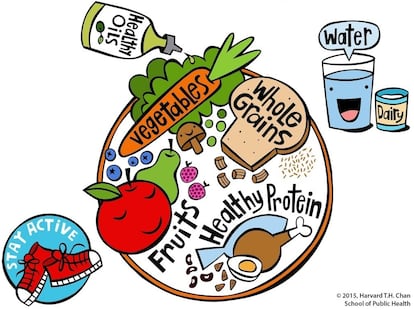The Harvard Kid’s Healthy Eating Plate: How it promotes healthy weight
The obesity epidemic does not spare children. Rigorous nutritional guidelines are one way to fight it

Food is one of the central concerns in raising a child. Parents want their little ones to grow up strong and healthy, and they often seek pediatricians’ advice to make sure their children develop in the healthiest way possible. Experts in health and nutrition have created numerous resources to assist in that process. Harvard University’s Healthy Eating Plate, a nutritional guide developed for both children and adults, is one of the best-known such models. The Healthy Eating Plate, released in 2011 and frequently updated since then, marked a 180-degree turn from previous nutritional standards. The guide replaced the food pyramid, which orders foods from less healthy to more healthy vertically, with a drawing of a plate whose four portions are represented by different colors. For the little ones, the plate is available in the form of a comic strip, released in 2015.
The need for rigorous, expert nutritional guidelines is oriented towards a clear objective: to end the global overweight and obesity epidemic, which doesn’t spare children. According to the World Health Organization (WHO), in recent decades, the rate of overweight and obesity has increased considerably. Worldwide, an estimated 170 million children under the age of 18 are overweight. In some countries, the number has tripled since 1980.
In the United States, one in five children between the ages of five and 19 suffers from the condition. As explained by the WHO, this high rate has serious consequences for the health of the youngest: “Raised BMI is a major risk factor for noncommunicable diseases such as cardiovascular diseases, diabetes, musculoskeletal disorders [and] some cancers.” It is also related to a decrease in children’s quality of life and an increased risk of teasing, bullying and social isolation. Guides for experts and parents seek to address the issue.
To that end, the Kid’s Healthy Eating Plate is “a visual guide to help educate and encourage children to eat well and keep moving. At a glance, the graphic features examples of best-choice foods to inspire the selection of healthy meals and snacks, and it emphasizes physical activity as part of the equation for staying healthy,” write its authors.

The plate consists of four essential food groups.
- The more vegetables, the better. “Potatoes and French fries don’t count as vegetables because of their negative impact on blood sugar.”
- Kids should “eat plenty of fruits of all colors,” the authors say. It’s better to eat them whole or cut than in a juice, and when opting for the latter, the guide recommends limiting consumption to one glass a day.
- When choosing grains, whole grains, or minimally processed whole grains, are preferred. The less processed the grain, the better. The authors also recommend whole grains–whole wheat, brown rice, quinoa and foods such as whole-grain pasta and 100% whole-wheat bread. Those products have a “gentler effect on blood sugar and insulin than white rice, bread, pizza crust, pasta, and other refined grains,” the authors note.
- As for healthy protein options, the Harvard health experts recommend legumes (beans, lentils and chickpeas), peas, nuts, seeds and other vegetable proteins, in addition to fish, eggs and poultry. They advise against consuming red meat (beef, pork and lamb) and processed meats (bacon, deli meats, hot dogs and sausages).
The experts add in their guide that vegetable oils, including olive, sunflower and corn, are preferable, and they advise limiting butter. They recommend a limited consumption of dairy products, including plain yogurt, small amounts of cheese and other dairy products without added sugar. And they point out that milk and other dairy products are a convenient source of calcium and vitamin D, but the optimal daily amount has yet to be determined.
Finally, the specialists insist that water is the best choice of beverage. They remind us that “just like choosing the right foods, incorporating physical activity into our day by staying active is part of the recipe for keeping healthy.” They recommend that children have one hour of physical activity each day.
Tu suscripción se está usando en otro dispositivo
¿Quieres añadir otro usuario a tu suscripción?
Si continúas leyendo en este dispositivo, no se podrá leer en el otro.
FlechaTu suscripción se está usando en otro dispositivo y solo puedes acceder a EL PAÍS desde un dispositivo a la vez.
Si quieres compartir tu cuenta, cambia tu suscripción a la modalidad Premium, así podrás añadir otro usuario. Cada uno accederá con su propia cuenta de email, lo que os permitirá personalizar vuestra experiencia en EL PAÍS.
¿Tienes una suscripción de empresa? Accede aquí para contratar más cuentas.
En el caso de no saber quién está usando tu cuenta, te recomendamos cambiar tu contraseña aquí.
Si decides continuar compartiendo tu cuenta, este mensaje se mostrará en tu dispositivo y en el de la otra persona que está usando tu cuenta de forma indefinida, afectando a tu experiencia de lectura. Puedes consultar aquí los términos y condiciones de la suscripción digital.
More information
Últimas noticias
Most viewed
- Sinaloa Cartel war is taking its toll on Los Chapitos
- Oona Chaplin: ‘I told James Cameron that I was living in a treehouse and starting a permaculture project with a friend’
- Reinhard Genzel, Nobel laureate in physics: ‘One-minute videos will never give you the truth’
- Why the price of coffee has skyrocketed: from Brazilian plantations to specialty coffee houses
- Silver prices are going crazy: This is what’s fueling the rally











































